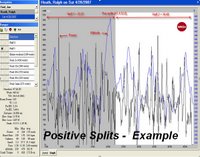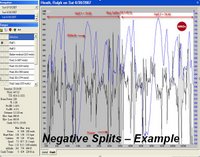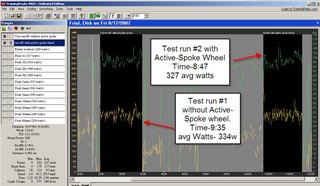How much should you eat?
A reader asked me to comment on how much an athlete should eat. Obviously, it is not possible to recommend an amount that works for every athlete. There are too many variables.
For example, yesterday I saw that Deena Kastor, the American women's marathon record holder, eats about 5,000 calories a day when training hard and about 3,000 when recovering or tapering. She is 5'4" and probably weighs less than 100 pounds so that is a lot of food. But I expect she runs in the neighborhood of 100 miles a week. This is probably about 10-12 hours weekly of training, much of it done at moderate to high intensity (the more intense the workout, the more calories are burned).
On the other hand, I coach a 56-year-old triathlete/road cyclist who weighs in at 156 pounds. He also trains, on average, about 12 hours a week with a significant amount of moderate to high intensity and eats around 2500 calories day, I expect. If he was to eat 5,000, or even 3,000, calories daily he'd soon look like the Michelin tire guy. He basically has to watch how much and what he eats every day, especially in mid-winter when he is trying to get back down to race weight after the holiday season and a break from training.
In terms of how much to eat, I like the Okinawan way of being aware of food intake. I understand that they stop eating when satisfied and about 80% full. We Westerners tend to eat until everything on the plate is gone regardless of how we feel. And the portions we consume, especially in restaurants, are huge. If weight control is an issue for you as it is for many of my client-athletes, following the Okinawan example would help a lot. You don't need to "clean your plate." Stop eating when no longer hungry.
But it isn't simply how much you eat, but also what you eat. My pet peeve with athletes is that they eat way too much starch. Starchy foods such as rice, bagels, bread, cereal and corn are the staples in many athletes' diets. Such foods are great for recovery. Eating them in the meal following a long and/or intense workout is a great way to restock your glycogen stores in preparation for the next workout. But contiuing to eat such foods as a significant source of calories outside of the narrow recovery window is a sure way to pack on excess poundage. And to make matters worse, most starches are very low in micronutrients (for example, vitamins and minerals)compared with vegetables. Once beyond the recovery window, micronutrient intake is the key to becoming more fit and healthy.
And to make matters worse, eating a high starch diet upsets the body's acid-base balance which ultimately results in the loss of bone calcium and muscle nitrogen. The only exceptions are potatoes, yams and sweet potatoes which raise body fluid pH levels and help to maintain bone density and muscle mass. This is what makes these particular starches the best possible recovery foods. All other starchy foods (along with dairy, legumes, meats, fish, nuts and eggs) have a tendency to increase acidity forcing the body to react to maintain pH balance by pulling calcium out of the bones and nitrogen out of the muscles (Remer and Manz 1995). Only fruits and vegetables have a net alkaline (acid-lowering) effect on the body's pH level. There is a great deal more that could be discussed on this topic and perhaps I will in a future post. I'd strongly recommend that you read Dr. Loren Cordain's and my book, The Paleo Diet for Athletes, for more details on this important topic and more.




